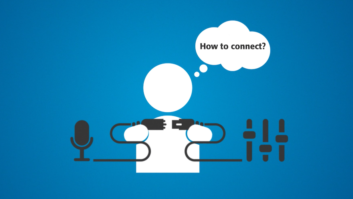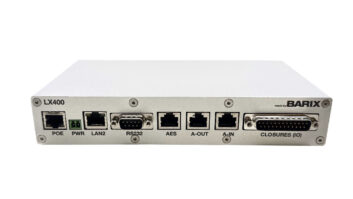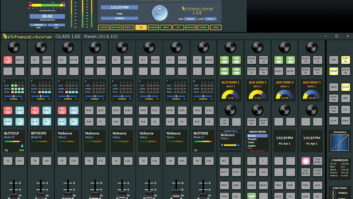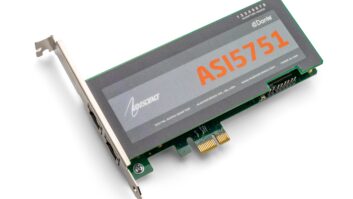ANTWERP, Belgium — NRJ België launched in Belgium’s Flemish region last September with a national frequency “package” for six commercial areas. The bundle consists of a license for each of the five provinces and one for digital (DAB+, digital TV, streaming).

SBS Belgium and the Mediahuis publishing company, proprietor of the Flemish Nostalgie Vlaanderen brand, own NRJ België. The station’s studios are located in the Mediahuis building in Antwerp together with Nostalgie’s studios, which, according to station staff, created some challenges during the installation of the new NRJ on-air studios.
With Nostalgie’s on-air studio’s being installed nearly a decade ago, and today’s fresh approach of studio building, investing in completely new studio gear was a logical step. “But throughout the design and research for the new facilities, we had to bear in mind that we wanted to achieve maximum compatibility with Nostalgie’s DHD-based on-air studios and the future NRJ studio,” said Luk De Groote, technical manager for both radio stations.
De Groote decided to team up with RadioStudio.be, a company specializing in integration and rental of broadcast equipment. “RadioStudio.be provided outside broadcast services for Nostalgie,” continued De Groote. “And that’s how I started talking with Tom Callebaut, the manager of the company.”
IP AND COMPATIBILITY
“The message was clear,” said Callebaut. “NRJ België wanted a futureproof on-air solution with full AoIP and compatibility. I suggested we use Lawo’s Ravenna-compatible technology for the two new studios. The keyword was scalability. In the past, you had a specific console or audio matrix and a fixed number of in/out’s. Today, we’re talking IP — the only limit being the bandwidth of your network.”
The assignment included the building, installation, acoustic design and technical integration of two studios for NRJ, with the option to use one for Nostalgie in a DHD setup. All content sources had to be interchangeable between the twin facilities and both radio products, requiring seamless, swift switching between both, without the audience noticing. In addition, the creation of a completely new on-air path for NRJ was part of the mission.
Both studios were equipped with Lawo Ruby AoIP mixing surfaces connected with a Lawo Power Core. “The majority of all input signals are via AoIP sources, widely available over the whole network,” explained Callebaut.
“The Ruby consoles are used as mixing engines but also for DSP, audio routing and conversion. The modular Power Core, with standard two AES67 and four MADI connections, offers exactly the scalability NRJ België required: To be able to expand the number of simultaneous channels to 10 or 35 with no need for extra devices. That was a major advantage in building these studios.

“The only analog inputs are microphones and studio monitors connected to the Power Core. All other sources like playout, telephone hybrid, codecs are AES67 AoIP streams to the Power Core audio routers in the main control room (MCR), with double compatibility — MADI for Nostalgie’s DHD platform and AoIP for future use. Everything is IP now, the days of discrete audio are almost completely gone.”
Mark Tito, sales director Lawo Benelux, said the project, in terms of equipment, was definitely on the edge of technology. “NRJ België is the first radio solution in Belgium adapting Ruby — and Power Core, which was actually just released when they decided for the product.”
KVM CONNECTIVITY
“We started from the basic idea not to have one single computer in the on-air studio,” underlined De Groote. “Software and systems that are running in the studio are connected over IP via KVM to the master control room.
Intronics supplied the KVM system. “The big advantages of implementing KVM are security, with all sources in a climate-controlled and dust-free environment, ergonomics (one module in the on-air room instead of computers), and multitasking, allowing multiple users to work simultaneously on the system, from any location,” explained Yves Van Hullebusch, account and project manager KVM at Intronics Belgium.

“For NRJ, we used the Adderlink XDIP PoE models: Six pairs of compact KVM receiver modules per studio, running completely over IP with a minimal latency of less than 25 ms. The system is extremely flexible as you don’t need any management servers — it can be expanded by means of Layer 2 switches. Every module is a standalone power-over-Ethernet unit, functioning either as transmitter or receiver. NRJ België’s on-air studio is among the first in Belgium implementing the XDIP solution, as it is a new platform.”
In the NRJ studios, 30 Adderlink XDIP units are used to display full HD images from the computers located in the MCR, on six screens. Two are configured for DJs or co-hosts and two have Zenon playout software, an editing screen for recordings, and a multipurpose screen to select a common source like the MultiCAM Radio system or a clone of the Zenon playout screen.
AIR CHAIN
The broadcaster stripped both studio rooms and added new acoustic materials from iDealAcoustics, which also designed and supplied the presenter desks. Each studio has room for four (self-op DJ, co-host and guests) seats, equipped with Neumann TLM 102 microphones on Yellowtec m!ka microphone arms.
“We decided to continue with Zenon Media radio software, an upgraded version of what our neighbors at Nostalgie are already using,” explained De Groote “The Zenon playout’s audio is routed via the Lawo R3LAY VSC drivers on the network to the Ruby desk core in the active studio where the signal is channeled to the Power Core in the MCR.”
[Read: Belgium’s RTBF Mix Crosses the Language Border]
“For the regional commercial breaks we use a blank/silence from the active studio program mixed with one of the six available commercial-players playing audio output on the AoIP network in the MCR. Each region has its own commercials but they are fully balanced,” said Callebaut. “The built-in silence detection in the Lawo Power Core monitors possible silence gaps and automatically switches on a slave playout computer or an SSD player, the silence detection is installed after the mix with active studio and one commercial regional output.”
The complete system was created in a redundant configuration for full backup, with switching almost inaudibly between both. A telephone hybrid from The Telos Alliance completed the setup. Callebaut added that the company is “excellent in delivering telephone systems. We are converting the Livewire signal to Ravenna, by means of an Axia xNode interface, making it AES67 compatible.”
The Power Core’s final signal is then channeled via six Orban Optimod 8600-S broadcast processors and six 2wcom MM01 codecs (one for each province, DAB+, streaming and DTV) to the transmitter sites using an IP connection.
“We put in place a completely new FM transmitter network and it had to be built up from scratch in less than two months,” said Christiaan Pladdet, business development manager with Broadcast Partners. “We attached a lot of importance to the design of the network ensuring maximum coverage within the license’s criteria. Each of the 16 transmitter sites is equipped with Elenos Indium transmitters and Lambda Technologies antennas. The 2wcom codecs serve multiple transmitter sites — in the past we had to install one codec for each transmitter — now we save in both rack space and energy.”
VISUAL RADIO

With one of NRJ’s owners being SBS Belgium, operating three TV channels in Flanders, the introduction of visual radio was evident. “NRJ’s morning show, hosted by Kim and Michaël, runs on the ZES TV channel between 6–9 a.m. using a MultiCAM Radio visual radio system,” said De Groote. “We are already using the system for Nostalgie using an AES soundcard. We moved three Panasonic AW-HE130 HD SDI cameras to NRJ’s on-air studio and installed the Lawo R3LAY VSC, capturing the audio feed for AoIP.”
“MultiCAM Radio receives GPIO and audio levels from the Lawo Ruby console via Ember Plus protocol. So it detects which microphone is open, and automatically controls the change of camera position, over IP,” explained Arnaud Anchelergue, MultiCAM director of sales. MultiCAM’s recording allows use of live streaming on different social media platforms and the station’s website. The audio-embedded SDI output of the system allows the splitting of audio (for transmission on Telenet’s radio Channel 943) and visual radio (for broadcast on ZES).”
All parties involved in the building of the on-air studios agreed that timing of the deployment was the most critical challenge. “We started brainstorming in May last year and one month later we embarked upon the endeavor. We subsequently began broadcasting in September. Meanwhile, we started refurbishing Nostalgie’s former back-up studio, took out the DHD and had new acoustics brought in to become our main on-air studio today.”
“It’s been 10 years since a new radio station in Flanders was launched and it’s amazing we managed to get NRJ on the air in such a short time span,” commented Tom Klerkx, managing director for NRJ and Nostalgie, “I’m proud of our tech team, who did the job. The basic product is now on track and we’ll continue refining the details in the coming months.”
The launch of NRJ on DAB+, mandatory in accordance with NRJ België’s broadcast license, took place in mid-April is backed by a marketing campaign.












